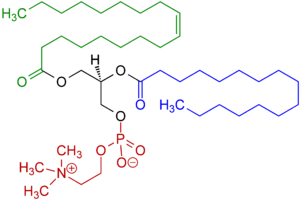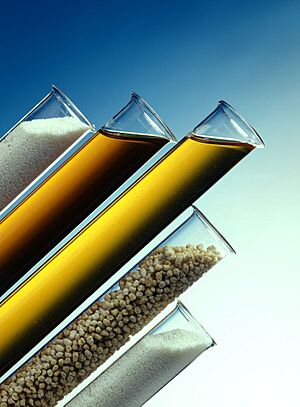Lecithin facts for kids
Lecithin (pronounced LESS-ih-thin) is a natural, fatty substance found in the cells of plants and animals. The name comes from the Greek word lekithos, which means "egg yolk"—the place where lecithin was first discovered.
Lecithin has a special ability: it's an emulsifier. This means it can help mix together ingredients that normally don't mix, like oil and water. Think about salad dressing—lecithin can keep the oil and vinegar from separating.
Because of this, it's a very useful ingredient in many foods. It helps make textures smooth, keeps ingredients blended, and prevents things from sticking to pans. It is found in everything from chocolate bars to cooking sprays.
Contents
The Discovery of Lecithin
Lecithin was first discovered in 1845 by a French chemist named Théodore Gobley. He was studying egg yolks and managed to isolate this unique fatty substance. He named it lécithine, from the Greek word lekithos, which means "egg yolk."
Later, Gobley found lecithin in many other parts of living things, including blood, lungs, and even the brains of humans and animals. This showed that lecithin is a very important substance for life.
How Is Lecithin Made?
Lecithin is usually made from plant sources. The most common sources are soybeans, sunflower seeds, and rapeseed (canola). It can also be found in egg yolks and marine foods.
To get the lecithin, the oil is extracted from the seeds. The lecithin is then separated from the oil. Commercial lecithin is a mix of different fatty substances called phospholipids.
Different Types of Lecithin
Sometimes, lecithin is changed to make it work better for a specific product. For example, it can be treated with special proteins called enzymes to change its properties. This is called hydrolysed lecithin.
Another process, called fractionation, uses alcohol to separate the different parts of lecithin. This can create a type of lecithin that is extra good at mixing things.
Genetically Modified (GM) Sources
Some crops, like soybeans, can be genetically modified (GM). This means their DNA has been changed by scientists. There are rules in some places, like the European Union, about labeling foods that contain ingredients from GM crops.
However, lecithin is highly processed. This means that by the time it's finished, it's almost impossible to tell if it came from a GM crop or not. To follow the rules, companies must keep careful track of where their soybeans come from.
What Is Lecithin Used For?
Lecithin is safe for humans to eat and is used in many different products, from food to paint.
In the Kitchen and in Foods
Lecithin is a popular food additive because it is so good at mixing and smoothing. In Europe, it is listed on food labels with the E number E322.
- In chocolate and candy: It keeps the cocoa butter and cocoa solids from separating. This gives chocolate its smooth, creamy texture and stops it from feeling greasy.
- In margarine and spreads: It keeps the oil and water mixed together, creating a stable spread. It also reduces how much the oil splatters when you use it for frying.
- In baking: It helps the ingredients in dough mix together evenly. It makes bread and cakes lighter and increases their volume. It also acts as a release agent, which is why it's used in non-stick cooking spray to stop food from sticking to pans.
- In powdered mixes: It helps powders like cocoa or protein mix dissolve easily in water instead of clumping up.
Other Everyday Uses
Lecithin isn't just for food. It has many other jobs:
- In medicines: It helps mix and stabilize the ingredients in some medicines and vitamin supplements.
- In animal feed: It adds nutrients and helps form the feed into pellets.
- In paints: It helps keep the pigments (colors) evenly mixed and stops them from settling at the bottom of the can. It also helps the paint spread smoothly.
- In plastics and textiles: It can be used as a release agent to help plastics come out of molds, and in other industrial processes.
Lecithin as a Health Supplement
Some people take lecithin as a dietary supplement. This is because it is a good source of choline, an essential nutrient that our bodies need to work properly.
Choline is important for the health of our brain, nerves, and cells. Our bodies can make some choline, but we also need to get it from the food we eat. Foods like eggs, meat, and soybeans are good sources.
Lecithin supplements are considered generally recognized as safe (GRAS) by the U.S. Food and Drug Administration (FDA). For people who have a soy allergy, lecithin made from sunflowers is a safe alternative.
Lecithin and Special Diets
Because lecithin can come from different sources, people who follow certain religious diets need to check where it comes from.
- For people who follow Jewish dietary laws, soy lecithin is sometimes considered kitniyot. This means some Ashkenazi Jews avoid it during the holiday of Passover.
- For people who follow Islamic dietary laws, the lecithin must be halal. Lecithin from plants or eggs is fine. If it comes from an animal, the animal must have been prepared according to Islamic rules.
Lecithin made from sunflowers is a great choice for many people because it is completely plant-based and avoids these concerns.
See also
 In Spanish: Lecitina para niños
In Spanish: Lecitina para niños




